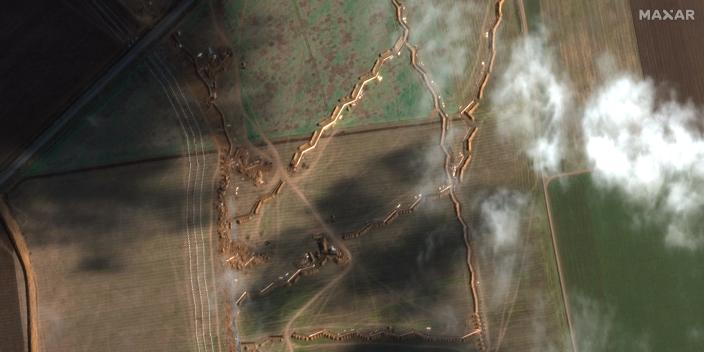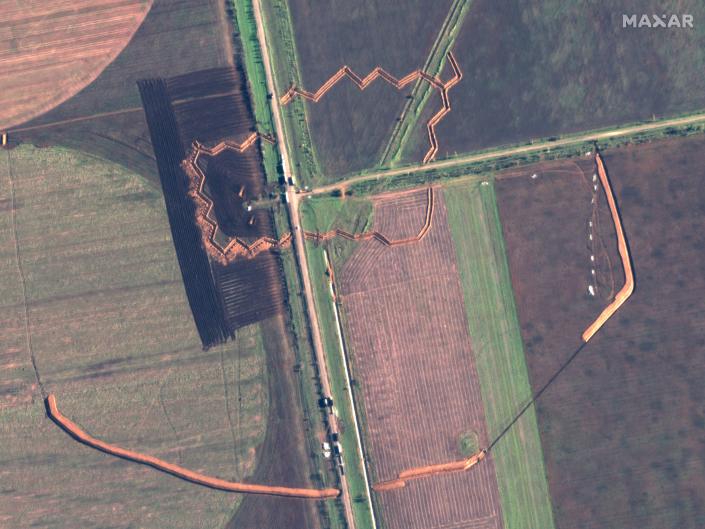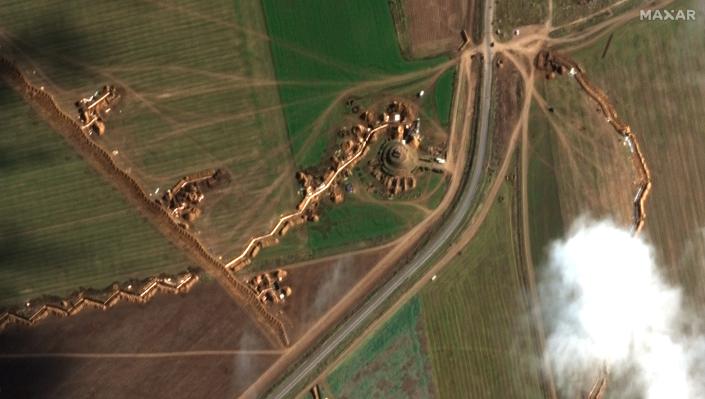
-
Russian troops have set up defense lines and positions in the area leading to Crimea.
-
But their fortifications focus on roads and highways, rather than fields and open terrain.
-
This is a gamble for Putin’s troops and could leave them vulnerable to Ukrainian offensives.
In the aftermath of the recent humiliating defeat in Kherson, a key southern city that has been under Russian occupation since the beginning of the war, Russia is now betting big on how to defend itself against further Ukrainian advances.
Recent satellite images captured by Maxar Technologies and obtained by Insider show multiple Russian defense positions in the eastern Kherson region, above the occupied Crimean peninsula, as Moscow tries to hold its own despite Ukraine’s ongoing successes on the battlefield.
Russian defense positions have been built along critical ground links such as roads and highways, connecting Russian forces on the Dnipro River to other occupied territories in the southeast, such as Crimea and the regions of Kherson and Zaporizhia, according to an assessment this week from the Institute for the Study of War (ISW), a Washington-based think tank.
These positions exist in the form of trenches and dragon-toothed anti-tank defenses, the ISW assessment said, referring to a decades-old strategy consisting of hardened fortifications built to slow and stop heavy armor. But instead of connecting lines of communication across the battlefield, the positions are more like “elaborate roadblocks” that don’t stray too far from the roads or the fields.



ISW believes the defensive positions indicate Russian military leaders are concerned about Ukrainian forces crossing the Dnipro River into the lower Kherson region. The nature of these positions is a gamble, however, because while Russia focuses on defending roads and highways, it ignores the real possibility that Ukraine could advance over open terrain.
Ukraine’s tanks and tracked vehicles could cut through fields and bypass them or attack Russian positions from their more vulnerable flanks.
“They’re not set up in a way that necessarily creates long, coherent lines of defense that cut across the country to the fields and things like that,” George Barros, an expert with the ISW, told Insider. This “suggests that the Russians expect to have vulnerabilities on the road and on the highways, and they don’t expect a drive across the country.”
Given the “geometry of the battlefield” and how the positions are set up, Russian forces could also be vulnerable to Ukrainian encirclement if they are able to advance from the eastern and western flanks in southern Kherson, Barros said. In addition, Ukraine could use precision strikes to threaten Russia’s communication lines.
Aside from this, Barros said that by establishing these defense lines, the Russian armed forces are also limiting themselves in their ability to conduct offensive operations in the area.
It remains to be seen exactly how Ukraine will build on its success in retaking Kherson – a counter-offensive that began months ago and went hand-in-hand with rapid advances in the country’s northeastern Kharkiv region. Since the end of the summer, advancing Ukrainian troops have managed to liberate thousands of square kilometers of territory from Russian occupation.
Ukrainian President Volodymyr Zelensky has previously and repeatedly vowed to expel Russian troops from all of Ukraine’s territory, including Crimea, which Russia illegally annexed in 2014. Crimean peninsula, indicating an uphill battle ahead given Russia’s reluctance to give up these companies.
Brig. General Oleksiy Hromov, the deputy chief of the main operational department of the General Staff of the Armed Forces of Ukraine, told reporters, according to the state news agency Ukrinform, that “the priority of the Russian Federation remains to maintain positions in the Donetsk and Luhansk regions”. , as well as the land corridor to the temporarily occupied territory of the Autonomous Republic of Crimea.”
Read the original article on Business Insider

